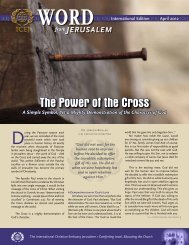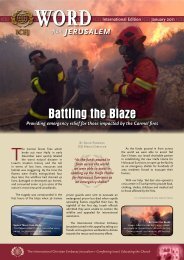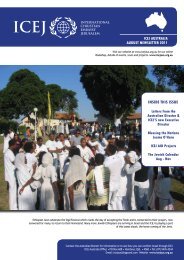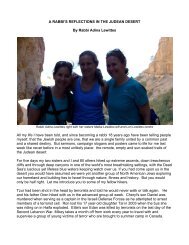WORD JERUSALEM
Mar/Apr 2004 - International Christian Embassy Jerusalem
Mar/Apr 2004 - International Christian Embassy Jerusalem
Create successful ePaper yourself
Turn your PDF publications into a flip-book with our unique Google optimized e-Paper software.
On Tour<br />
The ancient ruler Nimrod, called<br />
“a mighty hunter before the<br />
Lord” in the Bible and considered<br />
the founder of many modern<br />
cults, also left his legacy on<br />
the geography of Israel.<br />
Many sources credit Nimrod with<br />
attempting to build the tower of Babel and<br />
then establishing a religious system, with<br />
the help of his parents, which eventually<br />
became known as Baal worship.<br />
And according to other non-biblical legends,<br />
Nimrod dwelled on the summit where<br />
a fortress named after him now stands in<br />
northern Israel.<br />
Today, Nimrod’s Fortress, in the northernmost<br />
finger of the Golan Heights, stands<br />
majestically above the mountainous terrain,<br />
815 meters above sea level.<br />
Overlooking the fertile Hula valley from<br />
the shadow of towering Mount Hermon, the<br />
fortress’ impregnable stone towers jut from<br />
the side of the hill creating an intimidating<br />
vista. Below lies the road linking the<br />
Galilee region with Damascus – once a<br />
vital, narrow passage to the ancient Via<br />
Mare trade route.<br />
Seen from the roads below, the impressive<br />
appearance made for a foreboding<br />
military fortress back in the Middle Ages.<br />
Today a national park, visitors can inspect<br />
all corners of the well-kept ruins and enjoy<br />
amazing views, from the Sea of Galilee on<br />
one side to the snow-capped Hermon on<br />
the other. Hikers can trek up to the fortress<br />
either from the park’s entrance or from the<br />
nearby Banias National Park.<br />
The Crusaders were likely the first occupants<br />
of the fortress, built in the Middle Ages to<br />
defend the city of Banias, nestled in the valley<br />
below. Later, the Muslim rulers of Damascus<br />
rebuilt it to defend themselves against the<br />
Crusaders. During the 12th-13th centuries, the<br />
fortress changed hands several times, but it<br />
was maintained and strengthened mainly by<br />
Nimrod’s Fortress<br />
the Muslims, as attested to by the numerous<br />
Arabic inscriptions found on the building.<br />
One walks through the cavernous fortifications<br />
starting at the northwest tower.<br />
Within that tower and the southwest and<br />
western towers is a reservoir, several<br />
archery positions, Arabic inscriptions and<br />
spiral staircases made of huge stone slabs.<br />
Around every bend is another gutted<br />
tower, either square or a semi-circular,<br />
hanging over the hilltop edge with commanding<br />
views in every direction, demonstrating<br />
just how effective the fortress was.<br />
Visitors follow a guided path with descriptions<br />
at each numbered post that explain<br />
the history of each of the main segments.<br />
Continuing up the slope, one comes to<br />
“the keep”, a fortified location that stands<br />
above and independent of the fortress. In<br />
case the fortress was overrun, defenders<br />
retreated to the keep and continued the<br />
fight there. The keep served as living quarters<br />
for the commander of the fortress.<br />
During 1993-94, debris blocking the<br />
tower-gate on the western side of the<br />
fortress was cleared. On this side was found<br />
a deep moat cut into the rock, probably with<br />
a drawbridge, that protected its entrance.<br />
A large cistern was hewn in the rock<br />
beneath, and a narrow staircase connected<br />
the tower’s different stories. A 27-meterlong<br />
stepped, secret passage led from the<br />
gate tower to the outside. It would have<br />
enabled the defenders of the fortress to<br />
launch a surprise attack on besiegers or, if<br />
necessary, to flee from it.<br />
At the end of the 13th century, the<br />
Muslim conquest of the port city of Akko<br />
on the Mediterranean coast signalled the<br />
end of Crusader rule in the Holy Land. The<br />
Nimrod fortress lost its strategic value and<br />
fell into disrepair.<br />
“Cush begot Nimrod; he began to be a<br />
mighty one on the earth. He was a mighty<br />
hunter before the Lord; therefore it is said,<br />
‘Like Nimrod the mighty hunter before the<br />
Lord.’ And the beginning of his kingdom was<br />
Babel, Erech,Accad, and Calneh, in the land<br />
of Shinar. From that land he went to Assyria<br />
and built Nineveh, Rehoboth Ir, Calah, and<br />
Resen between Nineveh and Calah (that is<br />
the principal city). Genesis 10:8-12 ■<br />
- 21 -
















